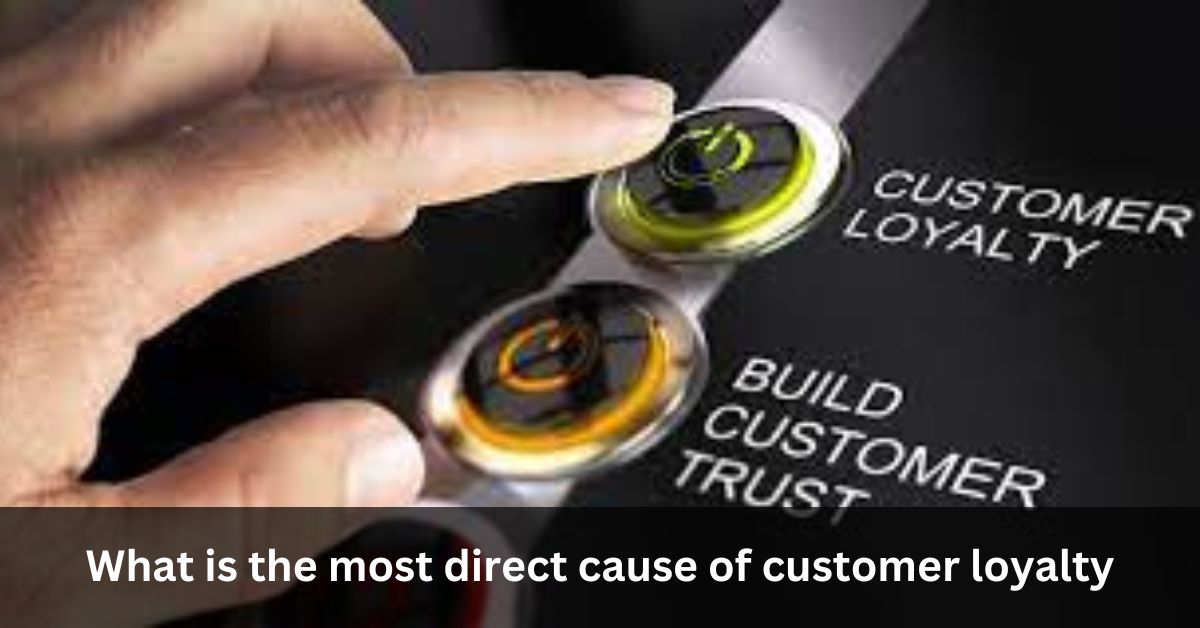What is the most direct cause of customer loyalty? In the chase of business growth, understanding customer loyalty is paramount. Reports and studies underscore its significance, with approximately 65% of company revenue stemming from repeat purchases by loyal customers. Furthermore, 57% of consumers tend to spend more with brands they feel loyal to.
However, the landscape of loyalty and its drivers has evolved over time, especially amidst events like the pandemic. Modern consumers seek more than just quality products or competitive pricing; they crave a deeper connection with brands.
For instance, among Gen Z buyers, 46% have ceased purchasing from companies based on their stance on social issues. Additionally, 53% express increased loyalty towards organizations with diverse customer service strategies.
In light of these shifts, What is the most direct cause of customer loyalty?
Understanding Customer Loyalty: A Comprehensive Overview
Before delving into the factors influencing, What is the most direct cause of customer loyalty? it’s essential to clearly understand what “customer loyalty” entails. It transcends mere positive brand perception; it involves customers consistently choosing to engage with a brand over time, irrespective of new market entrants.
Definition and Impact: Loyal customers exhibit a steadfast commitment to their preferred brand, prioritizing it over alternatives even if it means paying a premium or enduring longer wait times. Customer loyalty, fostered through positive experiences and a focus on customer satisfaction, not only boosts sales and lifetime value but also yields numerous other advantages for brands.
peopletools at&t: Navigating the Evolving Business Landscape
Benefits of Customer Loyalty:
- Increased Profits: Loyal customers generate recurring revenue streams and typically spend more per transaction compared to new customers.
- Reduced Marketing Costs: Acquiring new customers is significantly more expensive than retaining existing ones. By nurturing customer loyalty, companies can minimize expenditure on lead acquisition and capitalize on their customers’ advocacy.
- Competitive Advantage: A loyal customer base enhances a brand’s reputation and positions it favorably against competitors. Moreover, higher customer retention rates translate to greater stability in the market.
- Insights and Feedback: Loyal consumers provide invaluable insights that enable businesses to refine their offerings. Leveraging analytics and feedback management tools, companies can discern consumer preferences and tailor their products and services accordingly.
Deciphering the Primary Driver of Customer Loyalty:
The quest to identify What is the most direct cause of customer loyalty? persists among businesses seeking sustainable growth. While traditional factors like pricing strategies and product quality remain pivotal, contemporary consumers prioritize the overall customer experience.
- Customer Experience: A Key Determinant: In today’s landscape, exceptional customer support emerges as the linchpin of loyalty, as affirmed by a KPMG study indicating that 65% of respondents prioritize companies excelling in this domain. Moreover, research reveals that a staggering 86% of consumers are willing to pay a premium for guaranteed exceptional experiences.
- Evolution of Customer Expectations: In the era of digital transformation, consumers demand seamless interactions, personalized engagement, and authenticity across various channels. As AI and automation revolutionize contact center operations, the significance of “human experiences” becomes increasingly pronounced.
- The Role of Commitment: A business’s unwavering dedication to customer service throughout the consumer lifecycle is pivotal in cultivating loyalty, especially in the post-pandemic era marked by heightened consumer expectations.
- Additional Factors Shaping Loyalty: While exceptional experiences stand out as the primary driver of loyalty, it’s essential to acknowledge the multifaceted nature of customer loyalty. A holistic approach to customer service, backed by studies indicating that 93% of customers favor brands offering superior support, underscores the importance of factors beyond customer experience alone.
Elevating Customer Loyalty through Product, Brand, and Pricing
- The Quality of Your Product or Service: Customer loyalty hinges on the perceived value delivered by your product or service. While it doesn’t have to be the most cutting-edge solution, it must effectively address customer pain points and facilitate their goals. Mapping the customer journey, understanding buyer needs, and delivering tailored solutions are crucial steps in this regard. Direct feedback from consumers aids in creating more effective solutions.
- Brand Reputation and Values: In today’s dynamic landscape, understanding customer values is essential for delivering an exceptional experience. Brands known for honesty, transparency, and reliability foster stronger customer relationships. Aligning business values with customer preferences cultivates loyalty, with studies indicating that customers are more loyal to brands that resonate with their values.
- Pricing Structure: Fair pricing structures play a pivotal role in customer loyalty. While consumers prioritize good service over price, they expect value for their money. Companies need to demonstrate the reasonableness of their pricing based on the value provided. Additionally, offering incentives, loyalty programs, and membership benefits enhances perceived value and encourages customers to invest more in your solutions.
Asseturi Unveiled: A Comprehensive Guide
Enhancing Customer Loyalty through Convenience and Consistency
- Convenience: Customer effort score (CES) emerges as a critical factor influencing customer loyalty. Streamlining the customer journey to save time and effort is paramount. Companies can enhance convenience by offering online ordering, instant checkout, fast delivery, and omnichannel service. Leveraging AI and automation further simplifies interactions, such as enabling customers to place orders without agent assistance, thereby elevating loyalty rates.
- Consistency: Consistency is fundamental to excellent customer service in the digital era. Adopting an omnichannel approach ensures accessibility across various touchpoints. However, maintaining uniformity in support and guidance across channels is imperative. Consumers expect consistent access to high-quality advice, empathetic support, and straightforward solutions regardless of their interaction channel, fostering a seamless experience and bolstering loyalty.
- Emotional Intelligence: Human elements like transparency and empathy play a pivotal role in nurturing customer loyalty. Emotional intelligence in the contact center leads to positive and memorable interactions. Agents demonstrating compassion and patience are indispensable, particularly in a landscape dominated by automation and AI. Furthermore, emotional intelligence facilitates personalized customer service, as agents adept at understanding customer needs can tailor support accordingly, reinforcing customer satisfaction and loyalty.
Strategies to Enhance Customer Loyalty: Practical Insights:
What is the most direct cause of customer loyalty? Delivering exceptional customer experiences emerges as the cornerstone of fostering customer loyalty. By prioritizing CX, companies can transform their contact centers into profit centers, ultimately driving business growth. Here are some quick tips to cultivate and amplify customer loyalty levels:
Online Loans FintechZoom: Transforming Your Financial Journey
- Understanding Your Customers: Customers seek more than just efficient support; they desire evidence that companies comprehend their needs. Leveraging AI-driven conversational analytics and social listening tools enables organizations to gain valuable insights into customer sentiments and preferences. Collecting consumer feedback facilitates a deeper understanding of their pain points and aspirations.
- Streamlining the Customer Experience: Convenience, simplicity, and low customer effort scores are paramount to an excellent customer experience. Analyzing the customer journey helps identify friction points, allowing businesses to streamline touchpoints consistently. Investing in omnichannel contact centers ensures seamless service delivery across preferred channels. Simplified self-service solutions and agent training in effective communication further enhance the customer experience.
- Retaining the Human Touch: While AI and automation tools offer efficiency, human interactions remain invaluable. Consumers appreciate self-service options but also value the compassion and creativity of human agents. Ensuring customers can access knowledgeable and empathetic agents when needed is crucial. Training agents to enhance emotional intelligence fosters deeper connections and personalized experiences.
- Rewarding Loyalty: In today’s economy, where consumer loyalty is challenged, rewarding loyal customers becomes imperative. Implementing loyalty programs or rewards schemes adds value to customer relationships. Simple gestures, such as early access to new features, contribute to increasing loyalty levels.
- Listening to the Voice of the Customer: Consumer preferences evolve continuously, necessitating ongoing listening and adaptation. Voice of the customer technology aids in collecting feedback to understand the drivers of retention. Analyzing metrics like Net Promoter Score and CSAT rates alongside customer sentiment insights informs future CX strategies, enhancing the ROI of customer service initiatives.
Wrapping up: What is the most direct cause of customer loyalty?
Investing in What is the most direct cause of customer loyalty? is paramount for business success. By prioritizing exceptional customer experiences, brands can strengthen their reputation, drive revenue growth, and ensure sustained success in the competitive landscape.



